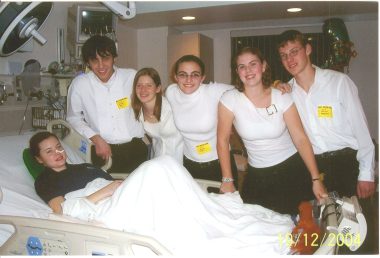How I Made It Through My Teenage Years With a Chronic Illness
Written by |

It’s hard enough being a teenager. What’s worse is when you add a chronic illness to the equation.
My particular vasculitis trajectory puts me in the minority. Many patients first show symptoms of inflammation in their 50s or 60s. But I fought for my life at 16, got diagnosed at 17, and reached remission at 25. Now in my mid-30s, I’ve already dealt with the disease for half of my life.
When I first presented with symptoms of severe onset granulomatosis with polyangiitis as a junior in high school, it took five months to be diagnosed. Part of the reason doctors had such a hard time pinning down my condition was because it wasn’t on their radar for a young person to have vasculitis.
Once my condition stabilized, I realized that the difficult part was just beginning. Now I had to take medications with traumatic side effects to see if we could stave off the inflammation. That didn’t even touch on the question of whether remission was possible.
The subsequent year was a flurry of healthcare scheduling, pain management, monitoring, and follow-up appointments. It was a struggle to get my immune system under control, let alone anything beyond that. After all, it made no sense to think about school if my semester was only going to be interrupted again. Health came first!
Growing up fast
Sixteen is a tumultuous age with many unknowns. Nearly everything that makes life worth living — relationships, education, a fulfilling career — is a huge question mark. What makes it more daunting is when you have to build your life around lab visits and doctor appointments.
Most kids that age don’t have to worry about these things. They feel immortal, if they consider their life span at all. They can take risks, explore, adventure, live on the edge. I couldn’t do any of that because it was hard enough to keep my disease from relapsing. The baseline was just getting through my day; it was a bonus if I could finish school.
Furthermore, it can be embarrassing for a young person to admit to an “old person’s illness.” In my many years of advocacy, I’ve discovered one certainty: The younger the patient, the less they want to talk about their condition. It’s there, but they tend to ignore it the best they can so they don’t become overwhelmed.
A disease like vasculitis is unique. Though it’s becoming less rare, it’s still highly uncommon. Plus, a chronic illness is something that makes a teen stand out, and the value of fitting in is never higher than during those years. They must juggle the complications of illness along with everything else going on in their lives.
The catch is that stress is believed to be a major factor in disease severity. So, ironically, the more a teen tries to get on with life after vasculitis, the more risk they might have for a relapse.

Friends from church helped me through the worst times. This photo was taken in 2004, a year before my diagnosis. (Courtesy of Allison Ross)
Leaning on a strong community
I consider myself lucky that I had one of the best groups of friends any teenager could ask for. My five closest friends from our church’s youth group visited me in the hospital during the darkest days, keeping spirits positive and faces bright (at least in front of me). When it was clear that I would survive the ordeal, our circle of friendship was stronger for going through that with one another.
Another community I have been grateful for is Vasculitis Foundation Pediatrics/Young Adults. This group joins together pediatrics and early adults for support and resources. Though we’re all in our 30s now, we nonetheless provide a foundation for younger people who are diagnosed as they come into the organization, letting them know that it’s not the worst experience to join the club.
I hope that my column today reaches someone, whether it’s a young patient or the parent of one, and offers some encouragement. Maybe you had a mild case of vasculitis but have dozens of questions you don’t know how to answer. Or maybe you’re going through the roughest years of your illness, worried about what college, dating, or a career might look like while sick.
Whatever the case, know that there is a space for you. Speaking as someone in it: The future is bright for us, especially with the growing community we have. And once you’ve battled illness so young, it gives you the tools — fortitude, emotional strength, time management, and empathy — to be healthy in other seasons of life as they occur.
Battling vasculitis as a teen is an unfortunate situation. But as with any challenge, if you educate yourself and surround yourself with the right people, you will overcome!
Note: ANCA Vasculitis News is strictly a news and information website about the disease. It does not provide medical advice, diagnosis, or treatment. This content is not intended to be a substitute for professional medical advice, diagnosis, or treatment. Always seek the advice of your physician or other qualified health provider with any questions you may have regarding a medical condition. Never disregard professional medical advice or delay in seeking it because of something you have read on this website. The opinions expressed in this column are not those of ANCA Vasculitis News or its parent company, Bionews, and are intended to spark discussion about issues pertaining to ANCA vasculitis.







Leave a comment
Fill in the required fields to post. Your email address will not be published.